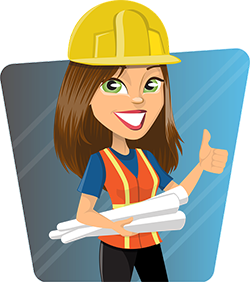 Employees who work all day at a computer are at risk for eyestrain. To help your workers protect themselves, we recommend that they follow these basic precautions.
Employees who work all day at a computer are at risk for eyestrain. To help your workers protect themselves, we recommend that they follow these basic precautions.
- Look away from the monitor for 30 seconds, every 15 or 20 minutes. Look at or scan things at least 20 feet away to allow your eyes to focus in a rest position.
- Reposition the monitor 20” to 26” from your eyes (roughly the distance from your eyes to the end of your index finger with arm outstretched). Otherwise, you’ll be forced to sit or lean too close to the screen, or sit too far away. If your eyeglass prescription doesn’t allow clear vision at the 20” to 26” range, get it adjusted.
Reset monitor height so that the top edge is even with your view when looking straight ahead. Then tilt the screen upward so that you’re not looking at the image at an angle. The optimal screen position is 10 to 20 degrees below eye level.
- Reset the monitor screen resolution, the Internet browser text size, and the zoom and font default in the operating system and in software applications so that text is easy to read. Start with a screen resolution of 800×600 for older CRT monitors and 1024×768 or higher for LCD (flat screen) monitors. Set the monitor refresh rate at or above 75 hertz (Hz) on older CRT models. Refresh rate is irrelevant for LCD monitors and is factory set, usually 60 Hz.
- Blink often (put a sticky note on your monitor!). The average blink rate is 22 times per minute. The rate goes down to seven per minute when looking at a monitor – which causes the eye lens to dry out. If you can’t get into the habit of blinking more often, use an eye moistener (saline solution).
- Relax your eye muscles. Put the palm of your hands over your eyes for a minute or so, once every half hour. This warms the muscles around the eyes, relaxing them.
- Minimize glare. Make sure the background light level around the monitor is about the same as the screen light level. Minimize direct sunlight or bright lights in front of the monitor or directly behind it.
- Adjust the contrast and brightness to levels you use when reading a book comfortably. A bright screen causes eyestrain.
Use a paper holder to hold documents. Put the document at the same level as the monitor, or attach it to the monitor. This prevents repetitive neck and eye movement from paper to screen.

 Federal laws may not mandate that your employer gives you sick leave, but some
Federal laws may not mandate that your employer gives you sick leave, but some United States citizens who receive a summons for jury duty must report to the courthouse and perform their civic duty. Your jury duty responsibilities could require anywhere from several hours to several months off work, though. What happens to your job and paycheck while you serve on a jury? Learn more about laws and your employer’s jury duty selection policy that affect your ability to get time off work and receive a paycheck when you’re called for jury duty.
United States citizens who receive a summons for jury duty must report to the courthouse and perform their civic duty. Your jury duty responsibilities could require anywhere from several hours to several months off work, though. What happens to your job and paycheck while you serve on a jury? Learn more about laws and your employer’s jury duty selection policy that affect your ability to get time off work and receive a paycheck when you’re called for jury duty. As a general contractor or subcontractor, you prioritize safety on every job site. A site-specific safety plan (SSSP) is one document you must have to fulfill OSHA requirements and establish guidelines that protect everyone who works on the project.
As a general contractor or subcontractor, you prioritize safety on every job site. A site-specific safety plan (SSSP) is one document you must have to fulfill OSHA requirements and establish guidelines that protect everyone who works on the project. Winter weather still rages strong in many parts of the United States in February, and you must continue to remain vigilant as you promote safety on the construction site.
Winter weather still rages strong in many parts of the United States in February, and you must continue to remain vigilant as you promote safety on the construction site. The construction industry relies on independent contractors who perform specialized services like plumbing, painting and drywall installation. To prioritize safety on the job site and ensure quality work, consider implementing a drug testing policy for the independent contractors you hire.
The construction industry relies on independent contractors who perform specialized services like plumbing, painting and drywall installation. To prioritize safety on the job site and ensure quality work, consider implementing a drug testing policy for the independent contractors you hire. A project architect or engineer typically carries responsibility for the design of a house, high rise or other structure. However, contractors now also play a role in project design and may be liable if something goes wrong. Consider the benefits of purchasing professional liability insurance and the process for gaining this valuable coverage for your contractor business.
A project architect or engineer typically carries responsibility for the design of a house, high rise or other structure. However, contractors now also play a role in project design and may be liable if something goes wrong. Consider the benefits of purchasing professional liability insurance and the process for gaining this valuable coverage for your contractor business. Safety remains your first priority as a parent. Whether you have one or a dozen kids, follow several car seat safety tips and protect your growing family.
Safety remains your first priority as a parent. Whether you have one or a dozen kids, follow several car seat safety tips and protect your growing family. Winter is almost over, but a variety of risks affect your safety as you drive. This month, perform a maintenance check on your vehicle as you improve safety and reduce
Winter is almost over, but a variety of risks affect your safety as you drive. This month, perform a maintenance check on your vehicle as you improve safety and reduce 





